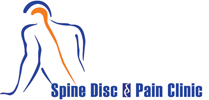The inter-vertebral discs are made-up of two concentric layers, the inner gel like Nucleus Pulposus and the outer fibrous Annulus fibrosus. As a result of advancing age, the nucleus looses fluid, volume and resiliency and the entire disc structure becomes more susceptible to trauma and compression. This condition is called as degeneration of the disc. The disc then is highly vulnerable to tears and as these occur, the inner nucleus pulposus protrudes through the fibrous layer, producing a bulge in the inter-vertebral disc. This condition is named as herniated disc. This can then cause compression to the spinal cord or the emerging nerve roots and lead to associated problems of Sciatica radiating pain from back to legs in the distribution of the nerve. Other symptoms could be weakness, tingling or numbness on the areas corresponding to the affected nerve. Sometimes bladder compromise is also present, which is made evident for urine retention and this need to be taken care as an emergency.
Excessive weight, bad postures, undue movements, improper weight lifting and other kind of traumas may weaken the intervertebral discs. When this occurs the pulpous nucleus will bulge against the annulus, or even be squeezed through it (extruded disc).
The first steps to deal with a herniated or prolapsed lumbar disc are conservative. These include rest, analgesic and anti-inflammatory medication and in some cases physical therapy. At this point it is convenient to have some plain X-rays done, in search of some indirect evidence of the disc problem, as well as of degenerative changes on the spine.
If in a few days these measures have failed, the diagnosis has to be confirmed by means of examinations that give better detail over the troubled area, as the MRI, CT which will show the disc, the space behind it and in the first case, the nerves. In some instances the EMG (electromyography) is also of great value, as this will show the functionality of the nerves and muscles.
Once the diagnosis has been confirmed, one of the best alternatives existing today is the Ozone Discolysis as the results obtained are excellent and practically has no complications. This novel treatment avoids the use of surgery in 80% of those who needed it. In most patients left with pain killers as the only treatment, the symptoms eventually disappear, only that this could take weeks to months. Ozone speeds up these developments, seen the same result in a few weeks. The problem has to be seen and approached integrally and frequently the combination of therapies has to be used, most frequently physiotherapy. Also, it has to be known that those who had a herniated disc have 10 times more chances of having another herniation than the rest of the population.
If despite the ozone therapy the symptoms persist, Drill Discectomy/ Laser Discectomy are good alternatives before open surgery (Discectomy) which has to be contemplated in those true emergencies, as mentioned above, this is possibly the first choice.
– See more at: http://spinenpain.com/diseases/slip-disc-sciatica/#sthash.MW6p9QGy.dpuf
ONCE THE CONSERVATIVE TREATMENT FAILS:-
Early aggressive treatment plan of pain has to be implemented to prevent peripherally induced CNS changes that may intensify or prolong pain making it a complex pain syndrome. Only 5% of total LBP patients would need surgery & 20% of discal rupture or herniation would need surgery. Nonoperative treatment is sufficient in most of the patients, although patient selection is important even then.
Depending upon the diagnosis one can perform & combine properly selected percutaneous fluoroscopic guided procedures with time spacing depending upon pt`s pathology & response to treatment.
Using precision diagnostic & therapeutic blocks in chronic LBP, isolated facet joint pain in 40%, discogenic pain in 25% (95% in L4-5&L5S1), segmental dural or nerve root pain in 14% & sacroiliac joint pain in 15% of the patients. This article describes successful interventions of these common causes of LBP after conservative treatment has failed.
LESI : LUMBAR EPIDURAL STEROID INJECTION
Indicated in – Acute radicular pain due to irritation or inflammation.
• Symptomatic herniated disc with failed conservative therapy
• Acute exerbation of discogenic pain or pain of spinal stenosis
• Neoplastic infiteration of roots
• Epidural fibrosis
• Chronic LBP with acute radicular symptoms
ESI TREATMENT PLAN:
Compared to interlaminar approach better results are found with transforaminal approach where drugs (steroid+ LA/saline +/- hyalase) are injected into anterior epidural space & neural foramen area where herniated disc or offending nociceptors are located. Whereas in interlaminar approach most of drug is deposited in posterior epidural space.Drugs are injected total 6-10 ml at lumbar, 3-6 ml at cervical & 20+ ml if caudal approach is selected. Lumbar ESI is performed close to the level of radiculopathy, often using paramedian approach to target the lateral aspect of the epidural space on involved side. Cervical epidural is performed at C7-T1 level.
SNRB- SELECTIVE NERVE ROOT BLOCK
Fluoroscopically performed it is a good diagnostic & therapeutic procedure for radiculopathy pain if
• There is minimal or no radiological finding.
• Multilevel imaging abnormalities
• Equivocal neurological examination finding or discrepancy between clinical & radiological signs
• Postop patient with unexplainable or recurrent pain
• Combined canal & lateral recess stenosis.
• To find out the pathological dermatome for more invasive procedures, if needed
INTRADISCAL PROCEDURES::
PROVOCATIVE DISCOGRAPHY: coupled with CT
A diagnostic procedure & prognostic indicator for surgical outcome is necessary in the evaluation of patients with suspected discogenic pain, its ability to reproduce pain(even with normal radiological finding), to determine type of disc herniation /tear, finding surgical options & in assessing previously operated spines
PERCUTANEOUS DISC DECOMPRESSION (PDD)
After diagnosing the level of painful offending disc various percutaneous intradiscal procedures can be employed:-
OZONE-DISCOLYSIS: Ozone Discectomy a revolutionary least invasive safe & effective alternative to spine surgery is the treatment of choice for prolapsed disc (PIVD) done under local anaesthesia in a day care setting. This procedure is ideally suited for cervical & lumbar disc herniation with radiculopathy. Total cost of the procedure is much less than that of surgical discectomy. All these facts have made this procedure very popular at European countries. It is also gaining popularity in our country due to high success rate, less invasiveness, fewer chances of recurrences, remarkably fewer side effects meaning high safety profile, short hospital stay, no post operative discomfort or morbidity and low cost.
DEKOMPRESSOR: A mechanical percutaneous nucleotome cuts & drills out the disc material somewhat like morcirator debulking the disc reducing nerve compression.
EPIDURAL ADENOLYSIS OR PERCUTANEOUS DECOMPRESSIVE NEUROPLASTY for EPIDURAL FIBROSIS OR ADHESIONS IN FAILED BACK SURGERY SYNDROMES (FBSS)
A catheter is inserted in epidural space via caudal/ interlaminar/ transforaminal approach
After epidurography testing volumetric irrigation with normal saline/ L.A./ hyalase/ steroids/ hypertonic saline in different combinations is then performed along with mechanical adenolysis with spring loaded or stellated catheters or under direct vision with epiduroscope.
– See more at: http://spinenpain.com/treatments/slip-disc-sciatica/#sthash.EFPUHPKa.dpuf








No Comments
This post is password protected. Enter the password to view any comments.